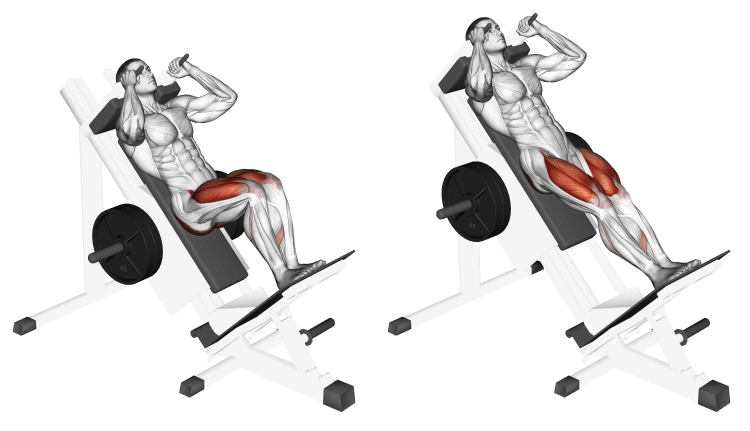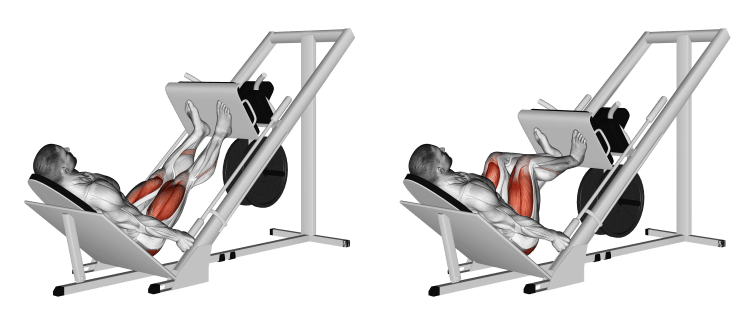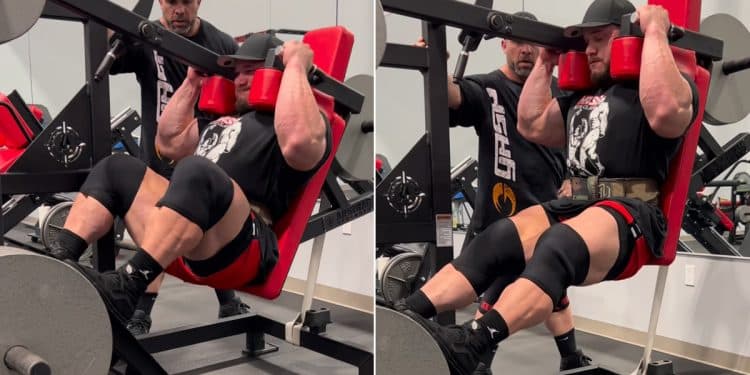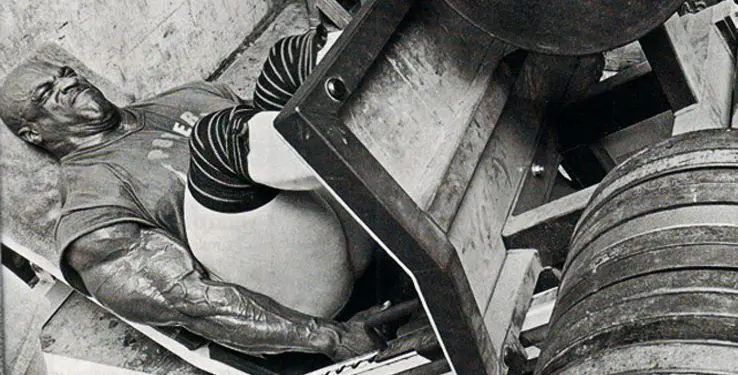Many people embark on their fitness journey driven by body-image concerns and challenges with self-confidence. For numerous bodybuilders, legs are a touchy subject, reflecting their dedication and prowess. If you ever mention ‘chicken legs’ to a lifter, you might catch a fleeting lapse in their confidence – however, for your safety, it’s advisable to refrain from such remarks, especially if the individual is notably larger.
When it comes to workouts, leg exercises hold significant importance. And there’s a reason for that. Legs represent the most expansive muscle group in our body. Consider this: during a leg workout, you’re essentially engaging nearly half of your body. Contrast this with a chest routine. By generous estimates, you might be working out roughly a fifth of your body. And even that could be an overreach because to train a full one-fifth would mean incorporating the upper back. So realistically, chest workouts might only cover about half of that one-fifth. This comparison highlights the undeniable importance of leg exercises. And when discussing prime leg workouts, the hack squat and leg press often spark debates.
So, what distinguishes these two prominent exercises? The key lies in muscle engagement. The hack squat, for instance, not only zeroes in on the quads and hamstrings but also actively engages the core and spinal erector muscles. Conversely, the leg press concentrates primarily on the quads and hamstrings.
While you might consider skipping a chest day, bypassing a leg session is a no-go. Training legs doesn’t just enhance your physique but also lays a robust foundation to boost athletic prowess.
Training legs offers benefits like:
- Hormonal stimulation, such as testosterone and human growth hormone (HGH) production
- Building stronger and more defined legs
- Enhancing core strength
- Boosting endurance, stamina, and explosive power
- Strengthening the lower back
- Typically burning more calories than upper-body routines
- Fortifying bones
- Improving mobility, stability, and range of motion
- Easing stress
- Bettering posture
While squats are often hailed as the ultimate leg exercise, comprehensive leg development demands versatility. Post the traditional squat, the hack squat and leg press emerge as two frontrunners in lower body workouts.
Level Up Your Fitness: Join our 💪 strong community in Fitness Volt Newsletter. Get daily inspiration, expert-backed workouts, nutrition tips, the latest in strength sports, and the support you need to reach your goals. Subscribe for free!
Given that both exercises rely on machines, they often present a quandary for lifters. This article delves deep into each exercise, elucidating their pros, cons, proper techniques, and their respective nuances.
Hack Squat and Leg Press Overview
Hack Squat

The squat is a functional exercise that trains your quadriceps, glutes, hamstrings, and core. Although it is primarily a leg exercise, it can help improve your overall fitness and strength levels.
Bodybuilding legends like Tom Platz, nicknamed “The Quadfather,” swore by the squat to build his monstrous legs. He, however, considered the hack squat a close second for its quad-building potential.
The hack squat is as close as a machine can get to mimicking the squat. This squat variation uses a sled mechanism to train your lower body. Using a plate-loaded sled removes the need to stabilize the bar, enabling you to lift heavier while maintaining a strong mind-muscle connection.
The hack squat machine comes with in-built safety pins that catch the sled if you fail to get out of the hole. Many lifters prefer the hack squat over the barbell squat when going heavy as they don’t need to stabilize the bar and don’t have to worry about failing at the bottom with big weights on their back.
Related: The Hack Squat Exercise Guide
Leg Press

The barbell and hack squat follow the same movement pattern — you support the weight on your shoulders. The leg press, however, takes a different approach. In this exercise, you place your back on the machine’s back pad and load your legs.
A trainer can usually lift heavier on the leg press than the barbell and hack squat. Don’t believe us? Here are the eight-time Mr. Olympia champion Ronnie Coleman’s personal records on the three lifts:
- Squat: 800 pounds (363 kilograms) x 2 reps (The Cost of Redemption, 2003)
- Hack Squat: 765 pounds (347 kilograms) x 8 reps (The Unbelievable, 2000)
- Leg Press: 2,400 pounds (1,089 kilograms) x 8 reps (The Cost of Redemption, 2003)
We know what you are thinking. The King’s squat is bigger than the hack squat. Coleman’s 800-pound squat was a two-rep-max attempt, attempted in 2003, whereas his hack squat was a hypertrophy-focused eight-rep set done in 2000.
Coleman was much bigger and stronger in 2003 than in 2000, and he could have easily outdone his 765 pounds for eight reps personal best in 2003 if he wanted.
Nonetheless, what’s mesmerizing here is the winningest’s Mr. Olympia’s leg press personal best. He completed eight reps with 2,400 pounds on the sled. The leg press machine ran out of space to hold more weight plates, and Big Ron’s coach and Metroflex gym owner Brian Dobson had to pop out a calculator to find out how much weight they had on the sled.
Related: The Leg Press Exercise Guide
Differences and Similarities Between a Hack Squat and Leg Press
Now that you know the basics of the hack squat and leg press, let’s discuss their differences and similarities. This breakdown will help you better understand each movement and how it can fit into your training regimen.
Differences between Hack Squat and Leg Press
Here is what separates the two lower-body resistance exercises:
1. Equipment
This is the most apparent difference. The hack squat consists of a sled with shoulder and back pads that moves at an angle within steel rails. You support the weight on your shoulders and back in this exercise. The machine comes with a stationary angled foot platform. It closely mimics the conventional barbell squat.
The leg press machine is the mirror opposite of the hack squat machine; the foot platform moves at an angle within steel rails while you rest your back and hips on the pads.
2. Range of motion
Both machines mostly use a 45-degree angled sled. The weight on each of these exercises will feel different because of your biomechanics and mobility. Lifters generally achieve greater depth on the leg press than the hack squat machine.
The hack squat machine requires upper and lower body involvement, whereas you only need to focus on your lower body on the leg press.
3. Muscles worked
The hack squat and leg press primarily targets the quads, hamstrings, and glutes. Furthermore, you’ll also experience greater core engagement while performing the hack squat because of the load on your back and shoulders.
You can change the target muscles in both exercises by switching your foot placement. For example, placing your feet high and wide on the leg press machine will emphasize your glutes and hamstrings, whereas planting your feet shoulder-width at the bottom of the foot platform will lead to greater quad stimulation.
4. Joint stress
Each gym equipment company manufactures its machines to a specification. The human body, however, comes in different shapes and sizes. An exercise that feels easy to you might feel uncomfortable to your training partner.
The squat is a functional movement involving multiple joints in the upper and lower body. Your biomechanics play a bigger role in this exercise than the leg press. You might feel greater stress in your knee and ankle joints on the hack squat than on the leg press.
5. Weight Used
The weight on the hack squat is on your shoulders and back, which makes it feel heavier than on the leg press. As a result, you can lift heavier on the leg press than on the hack squat machine.
Must Read: What Does PR Mean in Gym?
Similarities between Hack Squat and Leg Press
The hack squat and leg press have these factors in common:
1. Leg-focused exercises
The hack squat and leg press are lower-body exercises that target your quads, hamstrings, glutes, and calves. Changing your foot placement allows you to target different muscles. You could also change your rep tempo to train your muscles with varying intensity.
Level Up Your Fitness: Join our 💪 strong community in Fitness Volt Newsletter. Get daily inspiration, expert-backed workouts, nutrition tips, the latest in strength sports, and the support you need to reach your goals. Subscribe for free!
2. Resistance training
Both these exercises allow you to lift heavier than the conventional barbell back squat. It helps you turn up your workout volume and intensity. You must, however, ensure that you follow the correct form to get the best bang for your buck and limit the risk of injury.
3. Benefits for muscle growth and strength
Most lifters turn to the hack squat and leg press for strength and muscle gains. You must program your workouts for the desired results by changing your workout volume and intensity. Perform 8-12 reps of these lifts if you want to build muscle mass. Alternatively, stay in the 1-5 rep range to get stronger and build explosive power. [1]
How To Do the Hack Squat and Leg Press
Although both these exercises use machines, many lifters leave gains on the table by following an incorrect form and put themselves at higher odds of injury while training.
How To Do The Hack Squat
Here is how to do the sled hack squat for optimal results:
- Load the machine with the appropriate weight.
- Step onto the machine and position your shoulders, back, and head against the pads.
- Maintain your spine’s natural curvature for optimal range of motion.
- Place your feet shoulder-width apart on the foot platform and turn them out slightly. Place your feet slightly forward so you can enter a deep squat.
- Release the safety handles and grab onto the machine’s handles.
- Brace your core and lower yourself into a squat by bending at your knees. Go as low as possible.
- Explode back to the starting position by driving through your heels.
- Pause and contract your quads at the top.
- Repeat for recommended reps.
Pro Tips:
- Avoid locking your knees at the top to ensure constant tension on your quads.
- Driving through your heels will result in better glute stimulation. Push through your midfoot if you don’t want to emphasize your quads.
- Ensure that your lower back doesn’t come off the pad during the eccentric (lowering) motion.
- Avoid self-spotting by placing your hands on your knees. Save it for when training to failure.
- Adjust your stance and ankle angle based on your body mechanics. Use a posture that feels comfortable. Doing the exercise with an unnatural stance puts unnecessary stress on your joints.
In This Exercise:
- Target Muscle Group: Quads
- Secondary Muscles: Hamstrings, Glutes, and Calves
- Type: Strength
- Mechanics: Compound
- Equipment: Machine
- Difficulty: Beginner
- Best Rep Range:
- Hypertrophy: 8-12
- Strength: 1-5
How To Do The Leg Press
Use this technique to maximize your results:
- Load the machine with the desired weight.
- Sit down on the machine. Place your back and head on the back pad and your butt on the seat.
- Plant your feet shoulder-width apart in the center of the foot platform.
- Grab the support handles.
- Unrack the sled by pushing through your heels. Do not lock out your knees at the top.
- Release the safety handles.
- Take a deep breath and lower the weight as far as possible. Your lower back should not come off the pad at the bottom.
- Explode the weight to the start position by driving through your heels and exhaling sharply.
- Do not lock out your knees at the top. Pause and contract your quads.
- Repeat for recommended reps.
Pro Tips:
- Maintain a natural spine curvature. Pressing your back flat against the pad will put unnecessary stress on your lower back during the lift.
- If your lower back comes off the pad during the eccentric (lowering) motion, it is a sign of power lower body mobility.
- Placing your feet high on the platform will emphasize your glutes and hamstrings. Positioning them low on the platform focuses your quads. You must, however, ensure that you are not placing your feet too low on the platform, as it can overexert your knees.
- Placing your feet wide will prioritize your adductors, and having them close together will pull the focus on your abductors.
- Lifting your head off the pad puts unnecessary stress on your neck.
- Push through your heels to focus on your glutes and hams. On the other hand, pushing through the balls of your feet emphasizes your quads.
In This Exercise:
- Target Muscle Group: Quads
- Secondary Muscles: Hamstrings, Glutes, and Calves
- Type: Strength
- Mechanics: Compound
- Equipment: Machine
- Difficulty: Beginner
- Best Rep Range:
- Hypertrophy: 8-12
- Strength: 1-5
Common Mistakes — Hack Squat and Leg Press
Since the hack squat and leg press are lower body exercises that compete with the squat, people commit similar mistakes on these machines. Below are the most prevalent hack squat and leg press mistakes that you should avoid:
Going Too Heavy
Most lifters try to compensate for their poor barbell back squat strength by loading up the hack squat and leg press machines. Not only does this compromise the effectiveness of the exercise, but it also puts them at a higher risk of injury.
Not Following a Full Range of Motion
This is a continuation of the last point. Since most people resort to ego lifting on the hack squat and bench press, they cannot follow a full range of motion. Your quads must at least be perpendicular to your torso at the movement’s bottom.
Notably, some lifters take it to the opposite extreme. They bounce the sled off the safety pins at the bottom of the movement. Banging the sled at the bottom stresses your lower body joints and limits the exercise’s effectiveness because of the introduction of momentum.
Locking Your Kness at the Top
Fully extending your knees at the static contraction on the top is one of the most common mistakes lifters commit while doing the hack squat and leg press. Locking out your knees removes stress from your target muscles and puts it on your joints.
Excessive Self Spotting
Many exercisers spot themselves on these exercises by placing their hands on their knees or quads. Since both machine exercises don’t need you to balance the weight with your arms, lifters use this as an opportunity to cheat. You must hold the machine handles throughout the exercise and only use your hands for support in dire situations.
Upper Body Alignment
Maintain the natural arch in your back while performing these exercises. Your back and head should be on the pad throughout the range of motion. Lifting your head or lower back off the pad increases your odds of injury.
Types of Hack Squat and Leg Press Machines
Different gyms have different types of hack squat and leg press machines. These machines have unique designs and structures and train your muscles differently than the conventional 45-degree angles hack squat and leg press machine. This section covers some of the most common hack squat and leg press machines and how they train your lower body differently.
Types of Hack Squat Machines
Besides the conventional 45-degree sled hack squat machine, these are some common hack squat machines:
Power Squat
The power squat machine is the second-most common squat variation machine, and many lifters confuse the two. Both these machines have a unique movement pattern.
The 45-degree hack squat machine works up and down at the same angle, whereas the power squat machine follows an arc. The latter machine’s back pad is designed to move away from the foot platform during the eccentric (lowering) motion. This movement pattern puts more tension on the quads. Some lifters, however, might find it harsh on their knees and lower back. The power squat lets you perform glute and hamstring-focused squats by turning toward the back pad.
Pendulum Squat
The pendulum squat is a specialized training equipment. This machine’s unique pendulum-like movement pattern allows you to focus on your quads and glutes. Make the most of this machine if your gym has it.

Linear Hack Squat Machine
The linear hack squat machine is a variation of the conventional hack squat. This machine switches shoulder pads for lower back pads. Plus, the handles are at hip level compared to the shoulder-high grips on the traditional machine. This setup allows you to focus on your quads.
Horizontal Hack Squat
As the name implies, you work horizontally in this machine compared to the almost-vertical positions of the other hack squat machine variants. Since this machine works horizontally, it uses selectorized (pin) weights and works on a cable mechanism. The horizontal hack squat shocks your system because of its unique setup. You can switch your foot placement to target your quads, hams, and glutes.
Types of Leg Press Machines
Here are some popular leg press machines besides the standard 45-degree leg press:
Horizontal Leg Press
The horizontal leg press machine uses the same concept as the horizontal hack squat. In the horizontal leg press machine, however, the weight is supported on your back, whereas the horizontal hack squat machine uses shoulder pads. You sit upright on the horizontal leg press machine and push the weight directly in front of you.
You can change your target muscle group by altering your foot placement on the horizontal leg press machine. The horizontal leg press machine mainly differs from the conventional 45-degree leg press machine because of its cable pulley mechanism.
Notably, some plate-loaded leg press machines also use a semi-horizontal movement pattern. The angle of the foot platform changes during the eccentric and concentric motions, making it more joint-friendly.
Vertical Leg Press
This machine is a hamstring-focused leg press variant and uses a Smith machine-like mechanism where a foot platform is placed between two vertical steel rails. It is one of the best resistance exercises to train your hamstrings.
Hip Press
The hip press is a plate-loaded horizontal leg press machine variant. It is specialized training equipment and has you pressing horizontally at hip level to focus on your glutes. This machine’s design allows you to work through a bigger range of motion.
Advantages and Disadvantages of Hack Squat and Leg Press
Here are the pros and cons of the hack squat and leg press:
Hack Squat Pros
- Better Quad Development: Since the hack squat mimics the barbell back squat, it is more effective at working your quads than the leg press.
- Better Weight Distribution: The weight in this exercise is loaded on your shoulders, which helps in effective weight distribution and puts less load on your spine as your core and back jump into action.
Hack Squat Cons
- Harsh on Your Back and Shoulders: Using big weights on the hack squat can be unpleasant on the hack squat as you must hold it on your shoulders. Furthermore, some machines do not have comfortable shoulder pads.
- More Challenging For Beginners: The hack squat requires good mobility to perform with a full range of motion. The strict squatting form can be hard for beginners.
Leg Press Pros
- More Comfortable Than Hack Squat: You don’t have to hold the weight on your shoulders and back and are comfortably seated on the machine. This experience makes many lifters choose the leg press over the hack squat or barbell back squat.
- Better For Targetting Your Hamstrings: The mechanics of the leg press allow you to engage your hamstrings better. You can improve hamstring stimulation by pushing through your heels.
Leg Press Cons
- Spine Compression: This exercise is performed seated with your back supported, which makes it easier to lift heavier weights. It, however, leads to greater spine compression than the hack squat because your core and shoulders are not engaged in this lift.
- Ego Lifting: The leg press is the most abused machine in the gym. Folks stack on more weight than they handle and use a partial range of movement, leaving gains on the table.
Muscles Targeted on Hack Squat and Leg Press
Here are the muscles targeted on the hack squat and leg press:
Hack Squat
- Quadriceps
- Glutes
- Hamstrings
- Calves
- Abdominals
- Spinal erectors
Leg Press
- Quadriceps
- Glutes
- Hamstrings
- Calves
You can change your foot placement on each exercise to focus on different muscle groups. Furthermore, placing your feet wide and close can also engage your adductors and abductors in both machines.
Wrapping Up
The hack squat may better suit lifters trying to target quads and glutes. On the other hand, the leg press may be a better choice to focus on your hamstrings and glutes. Nonetheless, you can focus on specific muscles in both these exercises by switching your foot placement on the platform.
The hack squat and leg press are incredibly effective for lower body development and can help build strength and muscle mass. Both these exercises should be a part of your exercise arsenal as they can result in well-rounded lower body development. Use the tips mentioned in this article to get the most from these exercises and lower your risk of injury.
References
- Krzysztofik M, Wilk M, Wojdała G, Gołaś A. Maximizing Muscle Hypertrophy: A Systematic Review of Advanced Resistance Training Techniques and Methods. Int J Environ Res Public Health. 2019 Dec 4;16(24):4897. doi: 10.3390/ijerph16244897. PMID: 31817252; PMCID: PMC6950543.
Interested in measuring your progress? Check out our strength standards for Bench Press, Vertical Leg Press, Hack Squat, and more.












